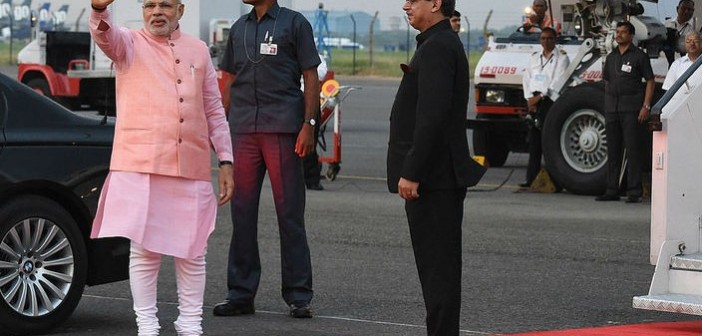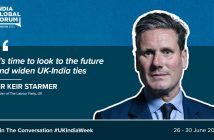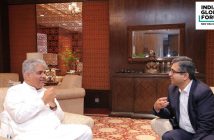Indian Prime Minister Narendra Modi will visit Washington at the end of September for his first official meeting with US President Barack Obama. It will cap a month of feverish, high-powered diplomacy, which, some say, could herald a more proactive phase in New Delhi’s engagement with the world.
Modi recently concluded a highly successful visit to Japan, which promised at least $35 billion in foreign investment in infrastructure projects. Japan will also support India’s efforts to build high speed rails links between key cities in an effort to yank the country’s creaking infrastructure into the 21st century.
Economic transformation and business topped the agenda during the visit but, uncharacteristically for an Indian leader, Modi took at dig at China’s expansionist tendencies. Addressing Japanese business leaders in Tokyo, he said: “We have to decide if we want to have vikaasvaad (development) or vistaarvaad (expansionism)… those having 18th century ideas engage in encroachments and enter seas (of others).”
Although he didn’t elaborate on his cryptic comment, there was no doubt in anyone’s mind that he was ticking off China for its hegemonistic tendencies in the South China Sea and for encroaching frequently into India along the border with Arunachal Pradesh and elsewhere.
Experts are sure these comments do not indicate an emerging strategic ganging up against China by Japan and India but one thing seems certain: India will no longer follow a reactive, please-all policy that was the hallmark of the previous Manmohan Singh government.
As he signalled, by walking out of the Trade Facilitation Agreement at the World Trade Organisation, Modi will brook no interference with India’s self-interest, regardless of what the world thinks. In this, he’s very different from all previous Indian Prime Ministers. It is a point President Obama and his advisors will do well to bear in mind when engaging with Modi.
Chinese President Xi Jinping will visit New Delhi before Modi leaves for the US. Experts and analysts will be watching out for tell-tale signs like body language, nuanced hints and (like Modi’s statement in Japan) even blunt comments to gauge the efficacy of the talks.
From the above and from the Indian government’s other pronouncements on important issues, it is likely that the following will feature prominently in the first summit-levels talks between India and the US since Modi assumed office.
After going through the usual platitudes about shared values, democracy, people-to-people ties, etc. the two leaders will have to address the drift that has marked the India-US relationship after the warmth and bonhomie that characterised ties under President George W. Bush.
Both sides are to blame for that. But how can this distance be bridged, so that the underlying convergence of goals and interests can be leveraged for mutual benefit and for global stability and peace?
The Obama-Modi Summit should set the tone for a “productive and fruitful” partnership for cooperation on both bilateral and global issues and “set an ambitious agenda to chart a new course in the mutual relationship between the two countries,” a recent statement issued by the Indian Prime Minister’s Office (PMO) said.
For Modi, it would seem, the interests of the two countries broadly converge and that there are few areas of serious differences. So, both sides should look at ensuring “concrete outcomes during the summit to take the relationship to an entirely new level, on the basis of vision, strategy and action plan,” the PMO statement added.
Pakistan and Afghanistan are two obvious areas of concern for India. A pet peeve – and a pretty genuine one – in New Delhi is that the US repeatedly winks at Islamabad’s proactive nurturing of terrorist groups active against India while urging India to show restraint and patience.
The US, obviously, has its own fish to fry in this region and as long as its policy establishment feels that there is merit in running with the hare and hunting with the hounds in Pakistan’s troubled backwaters, India will continue to feel frustrated and look askance at US anti-terror assertions.
This particular issue may not be easy to resolve, but from the Indian perspective, it’s critically important.
China remains the huge imponderable in Indo-US relations. Though the new Indian government would, instinctively, like to have closer strategic ties with the US, the situation on the ground, and the military asymmetry between the two Asian neighbours would stop it from embracing this idea more enthusiastically.
It will be interesting to see how Modi, especially after his comment in Tokyo, squares this circle.
But these are big picture, global alignments that might send foreign policy wonks into raptures but will barely be noticed by the millions of people who voted Modi to power.
One way President Obama can really put the India-US relationship back on track is by promising his unstinted support for Modi’s domestic agenda – by facilitating bilateral trade, by helping India in the fields of innovation, education and clean energy and by supporting India’s efforts to set up a vibrant agro-processing industry.
Each of these initiatives can transform the lives of millions of poor people. And every such life transformed will translate into greater support for the United States in the world’s largest democracy.
India is actively reaching out to the US for help on these issues. Wholehearted, unstinted and proactive help from Washington can help lift the currently moribund relationship to a new level.
It will be a time consuming process but the end result could be worth the effort.
Manoj Ladwa is the founder of India Inc and chief executive of MLS Chase Group @manojladwa







